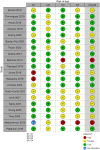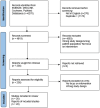The current state of the multidisciplinary heart team approach: a systematic review
- PMID: 39693114
- PMCID: PMC11754862
- DOI: 10.1093/ejcts/ezae461
The current state of the multidisciplinary heart team approach: a systematic review
Abstract
The heart team (HT) approach, recommended for managing cardiovascular diseases, emphasizes multidisciplinary collaboration. Despite its potential benefits, evidence on its effectiveness and implementation is varied and sparse. This review assesses the HT approach's impact on patient outcomes and care delivery in cardiovascular care. A systematic review was conducted across MEDLINE, EMBASE, PubMed, Cochrane and Google Scholar up to July 2023, focusing on studies that implemented an HT approach in coronary and heart valve disease management. Exclusion criteria included non-human studies, case reports and studies not focusing on HT outcomes. From 6270 identified articles, 20 met the inclusion criteria. These studies demonstrated significant variability in HT composition and organization, coupled with a lack of standardized metrics for evaluating clinical outcomes and the impact of the HT. Significant variability was observed in HT composition, with 13 of the 20 studies did not utilize structured templates, those that did demonstrated more consistent decision-making. In mitral valve interventions, HTs were linked to reduced in-hospital mortality and improved long-term survival (5-year survival probability of 0.74 vs 0.70, P = 0.04). In aortic valve interventions, 80% of patients underwent tailored valve procedures following HT evaluation. The HT approach in cardiovascular care demonstrates improved patient outcomes, particularly in specialized interventions for mitral and aortic valve diseases and coronary artery disease management. Despite these positive findings, the variability in HT implementation and the need for standardized outcome metrics call for further advances to optimize this collaborative care model.
Keywords: Aortic Valve Interventions; Cardiovascular Diseases (CVDs); Coronary Artery Disease (CAD); Mitral Valve Interventions; Multidisciplinary Heart Team (HT); Standardized Outcome Metrics.
© The Author(s) 2024. Published by Oxford University Press on behalf of the European Association for Cardio-Thoracic Surgery.
Figures





Similar articles
-
Implementing Formal Mitral Heart Team Improves Multidisciplinary Evaluation Rate and Survival of Patients With Severe Primary Mitral Regurgitation.J Am Heart Assoc. 2024 May 7;13(9):e033324. doi: 10.1161/JAHA.123.033324. Epub 2024 Feb 23. J Am Heart Assoc. 2024. PMID: 38390804 Free PMC article.
-
Community-based care for chronic wound management: an evidence-based analysis.Ont Health Technol Assess Ser. 2009;9(18):1-24. Epub 2009 Nov 1. Ont Health Technol Assess Ser. 2009. PMID: 23074522 Free PMC article.
-
Community-based care for the specialized management of heart failure: an evidence-based analysis.Ont Health Technol Assess Ser. 2009;9(17):1-42. Epub 2009 Nov 1. Ont Health Technol Assess Ser. 2009. PMID: 23074521 Free PMC article.
-
Continued expansion of the Heart Team concept.Future Cardiol. 2015 Mar;11(2):219-28. doi: 10.2217/fca.15.2. Future Cardiol. 2015. PMID: 25760880 Review.
-
An Individualized Approach of Multidisciplinary Heart Team for Myocardial Revascularization and Valvular Heart Disease-State of Art.J Pers Med. 2022 Apr 28;12(5):705. doi: 10.3390/jpm12050705. J Pers Med. 2022. PMID: 35629130 Free PMC article. Review.
Cited by
-
Advancing the Contemporary Multidisciplinary Heart Valve Team: Update on Priorities for Clinicians and Programs.Struct Heart. 2025 May 12;9(7):100490. doi: 10.1016/j.shj.2025.100490. eCollection 2025 Jul. Struct Heart. 2025. PMID: 40704360 Free PMC article. Review.
References
-
- Serruys PW, Morice M-C, Kappetein AP. et al.; SYNTAX Investigators. Percutaneous coronary intervention versus coronary-artery bypass grafting for severe coronary artery disease. N Engl J Med 2009;360:961–72. - PubMed
-
- Fihn SD, Gardin JM, Abrams J. et al. 2012 ACCF/AHA/ACP/AATS/PCNA/SCAI/STS guideline for the diagnosis and management of patients with stable ischemic heart disease. Circulation 2012;126:e44–e164. - PubMed
-
- Nishimura RA, Otto CM, Bonow RO. et al.; ACC/AHA Task Force Members. 2014 AHA/ACC guideline for the management of patients with valvular heart disease: a report of the American College of Cardiology/American Heart Association task force on practice guidelines. Circulation 2014;129:e521–643. - PubMed
-
- Baumgartner H, Falk V, Bax JJ. et al.; ESC Scientific Document Group. 2017 ESC/EACTS Guidelines for the management of valvular heart disease. Eur Heart J 2017;38:2739–91. - PubMed
Publication types
MeSH terms
LinkOut - more resources
Full Text Sources
Miscellaneous

